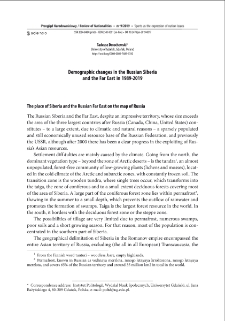Digital Library of Zielona Góra contains 9 312 digital objects
Object
Title: Demographic changes in the Russian Siberia and the Far East in 1989-2019
Group publication title:
Abstract:
Demographically, Siberia has been a remote and sparsely populated base of European Russia. The population of the Ural Federal District between 1989 and 2010 (within the borders of 2002) decreased by 0.45 million, Siberian Federal District by 4.90 million people and the Far Eastern Federal District by 1.65 million people. That is, the population of three federal districts decreased by 6.99 million people in just 21 years. ; In the years 2010-2019, the number of inhabitants of the Ural Federal District increased slightly from 12.08 million to 12.35 million people, i.e. by 0.27 million people. The population of the Siberian Federal District (within the borders of 2019) in the years 2010-2019 decreased by 0.004 million people. The number of inhabitants of the Far Eastern Federal District (within the borders of 2019) in the period 2010-2019 decreased by 0.18 million people. ; In total, in the years 2010-2019, the population of the three federal districts recorded a slight increase of 0.082 million people.
Publisher:
Zielona Góra: Oficyna Wydawnicza Uniwersytetu Zielonogórskiego
Format:
Resource Identifier:
DOI:
Pages:
Source:
Language:
License:
License CC BY-NC-ND 3.0:
Rights:
Biblioteka Uniwersytetu Zielonogórskiego
Object collections:
- Repozytorium > Jednostki organizacyjne > Wydział Nauk Społecznych
- Repozytorium > Typy utworów > Artykuły
- Repozytorium > Czasopisma naukowe i serie wydawnicze UZ > Przegląd Narodowościowy
Last modified:
Aug 31, 2023
In our library since:
Aug 31, 2023
Number of object content hits:
279
All available object's versions:
https://zbc.uz.zgora.pl/repozytorium/publication/82728
Show description in RDF format:
Show description in OAI-PMH format:
| Edition name | Date |
|---|---|
| Demographic changes in the Russian Siberia and the Far East in 1989-2019 | Aug 31, 2023 |
Objects Similar
Polański, Andrzej Kimmel, Marek Kimmel, Marek - red. Lachowicz, Mirosław - red. Świerniak, Andrzej - red.
Jerzak, Leszek Ciebiera, Olaf Boehner, Joerg
Chmielewski, Sławomir Iwańczuk, Cezary Kuropieska, Rafał Łukaszewicz, Marcin Szafrański, Adrian Tabor, Jacek Tęcza, Robert
Chmielewski, Sławomir Dombrowski, Andrzej Jabłoński, Piotr Łukaszewicz, Marcin Nicewicz, Łukasz Trębicki, Łukasz Pagórski, Piotr Tabor, Jacek
Bijith, Puthiyaveettil Roshnath, Ramesh
Skakauskas, Vladas Arino, Ovide - ed.
Fergola, Paolo Jiang, Liqiang Ma, Zhien Arino, Ovide - ed.
Covačev, Valery Arino, Ovide - ed.

